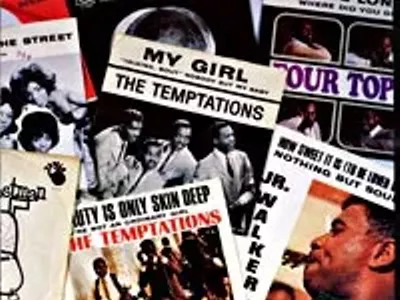Madonna
Madonna
Sire Records, 1983
Dance and sing, get up and do your thing: When the Bay City, Mich.-born 24-year-old named Madonna hiccupped her way onto NYC club playlists in late 1982 with the 12-inch single “Everybody,” it hardly presaged a career that would quickly turn the music world on its head.
“Let the music take control,” the pixie-voiced, peroxide-bobbed woman chirped innocently over a tres Chic disco beat. “Find a groove and let yourself go!” Infectious and insistent, sure, but not the sort of song that typically announces the arrival of Somebody Important; the single didn’t even surface on the pop charts.
Roads to superstardom are rarely only paved with gold and platinum singles, however, and besides, Madonna’s biggest belly flops make some of the biggest waves: “Everybody” didn’t register a blip on Billboard, but its street-level success did catch the ear of Sire honcho Seymour Stein. The short of the story is that — in a bit of “Behind the Music” melodrama — the ailing exec heard the song and had Madonna rushed to his hospital bedside to negotiate a record contract so she wouldn’t sign with another label. She got a $5,000 advance, released her self-titled dance-pop debut several months later and was on her way to global domination.
Not bad for a Midwest gal who, only seven years before, graduated from Rochester Hills’ Adams High School and, with the help of her dance instructor, the late Christopher Flynn, was heading off to the University of Michigan to make good on her dream of becoming a professional dancer. It was Flynn who also exposed the young Madonna to Detroit’s museums, restaurants, concerts and, perhaps most importantly, its thriving gay nightlife — providing her first experiences in the type of clubs that she’d later make her own, ones that would help launch her career.
“She loved it and, God, was she hot,” Flynn would say of their visits to the city’s homoclubs, excursions that supposedly began when Madonna was just 15. “She just cleared the floor and we just cut loose and everybody loved her. It’s not that she was showing off, she just thoroughly enjoyed dancing and it just sprang out of her.”
Despite a prestigious chance to work with renowned choreographer Pearl Lang in Ann Arbor, however, the restless Boy Toy-to-be bailed on college and Michigan to find stardom in the Big Apple in 1978.
The gamble paid off. Five years later, in September 1983, Madonna entered the Billboard 200, peaking at No. 8 and spawning three Top 20 hits: “Holiday,” the gold-certified “Borderline,” and its biggest single, “Lucky Star.” It hit the shelves as MTV was catching on, as disco waned and just after punk gave way to New Wave. The album quickly made Madonna a household name, at least among adolescent girls who began imitating her street-cribbed fashion sense. The record went on to sell more than 5 million copies in the United States alone — nowhere near the 10 million of 1984’s Like a Virgin, but impressive even by today’s bottom line-driven logic.
She wouldn’t secure her icon status for another year — with the release of the Thriller-sized music milestone, Like a Virgin, and her performance of the title track at the first MTV Video Music Awards, dry-humping the stage in a wedding dress — but it was Madonna, a gloriously infectious, quasi-concept album about letting music set you free, that introduced the world to pop’s future leading lady.
With the mirror ball as her muse on Madonna — dubbed The First Album abroad — she exalts the pleasures of moving and grooving under the strobe light, reveling in dance floor provocations just as she did on “Everybody.” “All of your moves are right/We can take it anywhere!” she exhorts on “Physical Attraction” over chintzy, tin-can keys and repetitive, rudimentary knob-noodling, and urging listeners to: “Let the music take you!”
Nearly two decades later, its production can sound flimsy and dated. Yet it remains one of the era’s best — eight simple, sparse and insidiously hooky disco infernos that take their cues from Detroit and Ann Arbor’s gay clubs, the NYC nightlife, Teena Marie, Debbie Harry, drag queen culture, and even punk (check the guitar-spiked squalls on “Burning Up”). Naysayers clung to the fact that it wasn’t the most innovative sound around and that her voice was waif-er thin, but technical virtuosity was never the point: Madonna broke taboos, not musical ground.
“I know I’m not the best singer and I know I’m not the best dancer,” she says in her tour documentary Truth or Dare. “But I’m not interested in that. I’m interested in pushing people’s buttons, being provocative and being political.”
Like any artist worth a damn, then, her radio-ready songs aren’t pop for pop’s sake — they’re platforms for Madonna to Say Something. Tracks such as “Like a Virgin” and “Papa Don’t Preach” are important markers in pop music for a number of reasons, but it’s Madonna’s boundary- and button-pushing — particularly concerning sexual and gender mores — that make her legendary and have caused her to become what is one of the most analyzed, ubiquitous and (in)famous figures in music history.
She’s been a lightning rod for controversy for so long now, too, that it’s easy to forget just how shocking she was when Madonna hit shelves. Her first video, “Burning Up,” featured her writhing around in the road, panting into the camera about her unquenchable desire and how, “unlike the others, I’d do anything ... I have no shame.” Compared with today’s pop tarts like Britney and Christina, the video is tame, banal even, but it caused a commotion of colossal proportion in 1983 and certainly paved the way for all future scantily clad chart-toppers.
Subsequent singles “Holiday” and “Borderline” upped Madonna’s visibility on radio and MTV even further, but it was “Lucky Star,” the disco song that went to No. 4 in the summer of 1984 — or, more precisely, its video — that solidified her celebrity and reputation for controversy. Singsonging for her lover to “Shine your heavenly body tonight” and baring her midriff as she bends over backward and rolls around on the floor, it was a star-making vehicle if there ever was one. It was the perfect way for Madonna, clad in a black, ragtag outfit against an all-white backdrop, to fully unveil the sexplicit image that would soon make her one of the world’s biggest stars.
Of course, it wasn’t her midriff that freaked out folks and inspired girls to start chopping shirts into halter tops; it was the power of her sexuality, and her belief in it, the way she acknowledged it and controlled it, the way she self-consciously toyed with it. Madonna embraced and mocked the virgin/whore complex, ironically flaunted her body as a self-sold commodity and challenged the male gaze all the way to the bank.
“Manipulating that state [of being female and watching people watch you] without breaking the spell of performing is what makes someone like Madonna brilliant,” wrote Sonic Youth’s Kim Gordon in 1987.
All of which amounted to what may be the biggest given in pop music today: For better or worse, Madonna has forever changed how the world consumes pop music. By flipping traditional gender scripts and exposing — and reveling in — the artifice of fame by merging art and commerce in shockingly blatant ways, she’s always been a savvy businesswoman/artist. Madonna not only upended the industry’s conventional notions of marketing, but made an impact so huge, so overanalyzed and criticized in everything from tabloids to academic journals, that even attempting to articulate anything new about her is superfluous.
For a generation of young women — and queer men — her impact is simple: She proved that there were nonacademic, street-savvy ways to express yourself and find empowerment. “For me and many other young ‘hip’ feminist women ... Madonna was a symbol of unrepressed female creativity and power — sexy, seductive, serious, and strong,” cultural critic bell hooks wrote of her early days, capturing exactly why the Material Girl so instantly became a phenomenon. “For a long while, her transgressive presence was a beacon, a guiding light, charting the journey of female ‘feminist’ artists coming to power — coming to cultural fulfillment.”
Not bad for the Michigan gal who just wanted, as she infamously told Dick Clark in 1984, to “rule the world.” Not bad at all.
Return to the introduction for this special collection of music stories, where you'll find links to the other nine records on our list of Detroit discs that shook the world.
Jimmy Draper writes about music for the Metro Times. E-mail him at [email protected]





